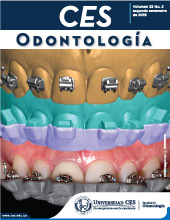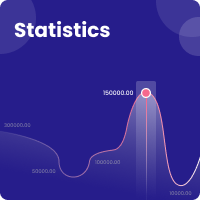Accuracy of Linear Measurements of Dental Models Scanned Through 3D Scanner and Cone- Beam Computed Tomography in Comparison with Plaster Models
DOI:
https://doi.org/10.21615/cesodon.32.2.1Keywords:
Cone-beam computed tomography, orthognathic surgery, dental archAbstract
Introduction and objective: Virtual surgical planning uses clinical data, image testing, plaster models of dental arches and clinical photos to simulate an orthognathic. There are two ways to perform the scanning of plaster models: scanning for cone-beam computed tomography (CBCT) or 3D scanner. The purpose of this study was to assess the accuracy and the degree of magnification of plaster model images obtained through 3D scanner and CBCT. Materials and methods: The control group was the measurement performed on 40 plaster models by Mitutoyo caliper. The same 40 models were scanned through 3D scanner and CBCT in order to compare the degree of distortion. The models were tested on the Dolphin software. Six measurements were performed in upper and lower arches: intermolar distance; intercanine distance; segment A; segment B; mesiodistal and cervicoincisal distance of the right-side central incisor. Results: There was no statistically significant difference for upper and lower models. However, CBCT had the degree of distortion of 2.34%, while the 3D scanner presented the degree of distortion of 2.37% comparing the degree of distortion of both methods with the digital caliper. Conclusions: It can be concluded that only the distances of segments A and B of the upper model were not compatible in both scanning methods with the measurements of digital caliper. However, considering all of the measurements, 3D scanner and CBCT are trustworthy to perform linear measurements on digital models and are sufficiently adequate for initial diagnosis and and are clinically acceptable in clinical dental practices.
Downloads
References
Stokbro K, Aagaard E, Torkov P, Bell RB, Thygesen T. Virtual planning in orthognathic surgery. Int J Oral Maxillofac Surg 2014;43(8):957-965.
Xia JJ, Shevchenko L, Gateno J, Teichgraeber JF, Taylor TD, Lasky RE, et al. Outcome study of computer-aided surgical simulation in the treatment of patients with craniomaxillofacial deformities. J Oral Maxillofac Surg 2011; 69(7):2014-2024.
Baumgaertel S, Palomo JM, Palomo L, Hans MG. Reliability and accuracy of cone-beam computed tomography dental measurements. Am J Orthod Dentofacial Orthop 2009;136(1):19-25.
De Vos W, Casselman J, Swennen GR. Cone-beam computerized tomography (CBCT) imaging of the oral and maxillofacial region: a systematic review of the literature. Int J Oral Maxillofac Surg 2009;38(6):609-625.
Chen LH, Chen WH. Three-dimensional computer-assisted simulation combining facial skeleton with facial morphology for orthognathic surgery. Int J Adult Orthodon Orthognath Surg 1999;14(2):140-145.
Motohashi N, Kuroda T. A 3D computer-aided design system applied to diagnosis and treatment planning in orthodontics and orthognathic surgery. Eur J Orthod. 1999;21(3):263-274.
Xia J, Ip HH, Samman N, Wang D, Kot CS, Yeung RW, et al. Computer-assisted three-dimensional surgical planning and simulation: 3D virtual osteotomy.Int J Oral Maxillofac Surg 2000;29(1):11-17.
Terajima M, Nakasima A, Aoki Y, Goto TK, Tokumori K, Mori N, et al. A 3-dimensional method for analyzing the morphology of patients with maxillofacial deformities. Am J Orthod Dentofacial Orthop 2009;136(6):857-867.
Gateno J, Xia J, Teichgraeber JF, Rosen A. A new technique for the creation of a computerized composite skull model. J Oral Maxillofac Surg 2003;61(2):222-227.
Uechi J, Okayama M, Shibata T, Muguruma T, Hayashi K, Endo K, et al. A novel method for the 3-dimensional simulation of orthognathic surgery by using a multimodal image-fusion technique. Am J Orthod Dentofacial Orthop 2006;130(6):786-
Kim BC, Lee CE, Park W, Kang SH, Zhengguo P, Yi CK, et al. Integration accuracy of digital dental models and 3-dimensional computerized tomography images by sequential point- and surface-based markerless registration. Oral Surg Oral Med Oral Pathol Oral Radiol Endod 2010;110(3):370-378.
Noh H, Nabha W, Cho JH, Hwang HS. Registration accuracy in the integration of laser-scanned dental images into maxillofacial cone-beam computed tomography images. Am J Orthod Dentofacial Orthop 2011;140(4):585-591.
Fleming PS, Marinho V, Johal A. Orthodontic measurements on digital study models compared with plaster models: a systematic review. Orthod Craniofac Res 2011;14(1):1-16.
Jacobs S, Grunert R, Mohr FW, Falk V. 3D-Imaging of cardiac structures using 3D heart models for planning in heart surgery: a preliminary study. Interact Cardiovasc Thorac Surg 2008;7(1):6-9.
Quimby ML, Vig KW, Rashid RG, Firestone AR. The accuracy and reliability of measurements made on computer-based digital models. Angle Orthod 2004;74(3):298-303.
Veenema AC1, Katsaros C, Boxum SC, Bronkhorst EM, Kuijpers-Jagtman AM. Index of Complexity, Outcome and Need scored on plaster and digital models. Eur J Orthod 2009;31(3):281-286.
Keating AP, Knox J, Bibb R, Zhurov AI. A comparison of plaster, digital and reconstructed study model accuracy. J Orthod 2008;35(3):191-201; discussion 175.
Bootvong K, Liu Z, McGrath C, Hägg U, Wong RW, Bendeus M, et al. Virtual model analysis as an alternative approach to plaster model analysis: reliability and validity. Eur J Orthod 2010;32(5):589-595.
de Waard O, Rangel FA, Fudalej PS, Bronkhorst EM, Kuijpers-Jagtman AM, Breuning KH. Reproducibility and accuracy of linear measurements on dental models derived from cone-beam computed tomography compared with digital dental casts. Am J Orthod Dentofacial Orthop 2014;146(3):328-336.
Lee SM, Hou Y, Cho JH, Hwang HS. Dimensional accuracy of digital dental models from cone-beam computed tomography scans of alginate impressions according to time elapsed after the impressions. Am J Orthod Dentofacial Orthop 2016;149(2):287-294.
Vandenbroucke JP, Tijssen JGP. Klinische Epidemiologie en biostatistiek. Codex Med., pp. 1297–1316.
Camardella LT, Breuning H, Vilella OV. Are there differences between comparison methods used to evaluate the accuracy and reliability of digital models? Dental Press J Orthod 2017;22(1):65-74.
Grünheid T, Patel N, De Felippe NL, Wey A, Gaillard PR, Larson BE. Accuracy, reproducibility, and time efficiency of dental measurements using different technologies. Am J Orthod Dentofacial Orthop 2014;145(2):157-164.
Hajeer MY, Millett DT, Ayoub AF, Siebert JP. Applications of 3D imaging in orthodontics: part II. J Orthod 2004;31(2):154-162.
Downloads
Published
How to Cite
Issue
Section
License
Copyright (c) 2019 CES Odontología

This work is licensed under a Creative Commons Attribution-NonCommercial-ShareAlike 4.0 International License.
| Article metrics | |
|---|---|
| Abstract views | |
| Galley vies | |
| PDF Views | |
| HTML views | |
| Other views | |



